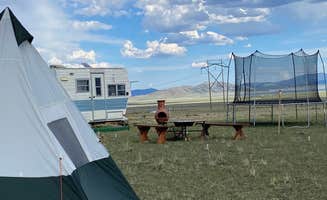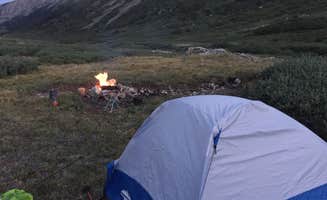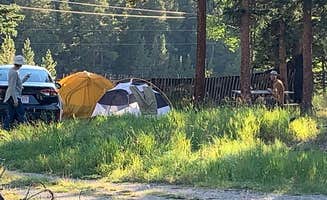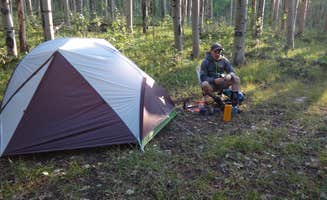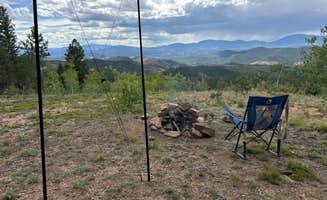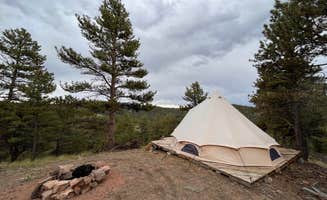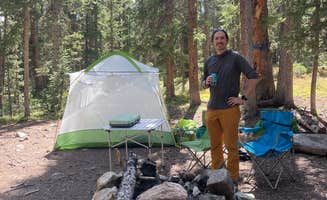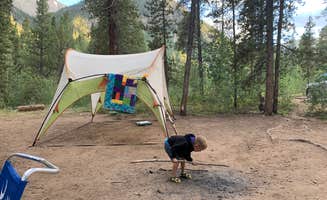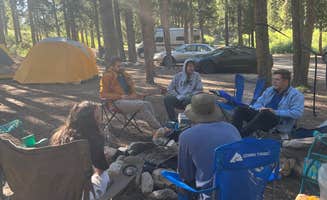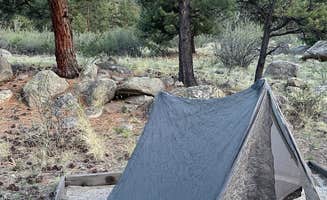Primitive tent campsites near Hartsel, Colorado occupy public lands across Pike and San Isabel National Forests. This high-altitude region sits at elevations between 8,800 and 12,000 feet, creating marked temperature differences between day and night throughout the camping season. Most dispersed areas lack infrastructure beyond fire rings, with campers encountering subalpine forest conditions dominated by aspen, pine, and open meadow terrain.
What to do
Hike the Collegiate Peaks: Access multiple 14,000-foot mountains from North Cottonwood Trailhead Dispersed Camping near Buena Vista. "We hiked the trail to Kroenke Lake in the morning. Great spot!!" notes Kelsie S.
Explore mountain lakes: Primitive tent areas near Twin Lakes provide access to pristine alpine waters. "If you have a 4x4 vehicle and can make your way toward the trailhead for south Mt Elbert, there are some amazing spots...right on the end of Lily Ponds," writes Brielle E.
Wildlife viewing opportunities: Cattle and wildlife sightings are common at primitive sites. At Matukat Road Dispersed Camping, "Livestock do graze in the area, we saw a herd of cows that initially we thought were bears so we had a split second of worry before realizing what they were," reports John M.
Mountain biking access: Forest roads throughout the region provide mountain biking routes with campsites serving as staging areas. "There are a lot of really good options you can just park your car at. You can also get pretty far up the trail in a standard car," explains Brandon M.
What campers like
Solitude and spacing: Most dispersed areas offer separation between sites. At McCullough Gulch Designated Dispersed Camping, "Didn't see another person on a Wednesday night. Very peaceful and plenty of spots to choose from," writes Justin J.
Natural features: Campers appreciate unique landscape elements near tent sites. "We found a nice spot right next to the creek with room for several cars and framed in by trees. Sounds of water is awesome. Couldn't hear any other campers," shares Kelsie S.
Accessibility for smaller vehicles: Many primitive areas can be reached without specialized transportation. On Matukat Road, John M. notes: "Plenty of campsites to choose from and accessible with 2WD (at least during the summer). Arrived mid-afternoon on a Friday and had our pick of the sites."
Strategic basecamp locations: Tent sites serve as starting points for major hikes. A camper at Chaffee County Road 390 Dispersed explains: "We stayed here one night before some 14er hiking the next morning. Rolled in around 9PM on a Wednesday and had a ton of places to camp."
What you should know
Road conditions vary significantly: Access to tent camping areas requires careful route planning. For Boreas Pass Road Designated Dispersed Camping, a camper advises: "Road is fine for high clearance. But all of us with 4WD ask that you move over for us."
Temperature fluctuations: Nights remain cold even in summer. At McCullough Gulch, Justin J. reports: "Temps were high 70s in the evenings and low 40s at night in mid July so prepare with layers."
Sites fill predictably: Weekend arrivals face competition for prime spots. "We drove up from Denver Saturday morning... Great trail. Rained a little but it was not a big deal. Decent amount of traffic on the road throughout the day and into the evening. Really cool to be able to snag a spot around lunchtime on a Saturday," says Luke R.
Limited infrastructure: Most sites completely lack facilities. "These sites are dispersed camping, no amenities. No metal fire rings, picnic tables, restrooms or trash bins," notes Anthony P.
Tips for camping with families
Stream access for kids: Look for sites with natural water features. Near Twin Lakes Dispersed Camping - Site 2 West, "We found a great spot that had several fire rings and lots of space for parking," reports Myrinda G.
Designated camping with clear boundaries: Designated dispersed areas provide structure without strict campground rules. At McCullough Gulch, one camper details: "Campsites are clearly marked 1-6, but there may be others...Campsite 1: We stayed here...Very nice wooded area that even 2 smaller trailers could camp in. Lots of nice places for tents. Might be a good group camping area."
Moderate outdoor activities: Some tent camping areas offer milder recreation options. Along Matukat Road, Chris P. mentions: "There's good hiking the area as well. The road getting in was doable. We didn't need to engage the four-wheel-drive so the only thing I would advise is you need some reasonable clearance to get all the way back in here."
Avoid peak traffic periods: Road traffic disturbs some tent sites. At Chaffee County Road 390, a camper warns: "TONS OF TRAFFIC. Like I said, it was Labor Day weekend so it's to be expected - but the trucks/cars/rvs driving past our site (which was still a little ways off the road) towards the large campsite in Winfield kicked up a lot of dust."
Tips from RVers
High clearance vehicles only: Most tent camping areas have constraints for larger vehicles. At McCullough Gulch, Rebecca B. cautions: "If you are in a tent, these may provide some great options. We went by the first 6 sites. Even with our lifted AWD van, there were sites we didn't want to drive up to."
Limited turn-around space: Consider vehicle positioning before committing to narrow roads. "A large RV or trailer might be able to just pull in to an area straight down road, but it would be facing the wrong direction and backing out would be challenging," advises a camper at McCullough Gulch.
Satellite connectivity issues: Dense forests block satellite signals. "It is heavily wooded, so if you need Starlink that likely would not work," notes Rebecca B.
Parking layout planning: Some dispersed areas require strategic vehicle placement. At Railroad Bridge, Shane W. explains: "You park in a spot in the lot and carry your stuff to your site. The $28 doesn't include a vehicle pass if you don't have a state park pass."


